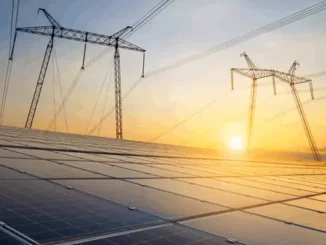
A group of Massachusetts solar installers are working with the state to modify fire codes that they say are too restrictive and are limiting the scale of residential solar arrays.
“We are not at the finish line, but both sides have been extremely cooperative and collaborative,” said Nick D’Arbeloff, vice president of commercial for SunBug Solar and the vice president of the Solar Energy Business Association of New England. “The dialogue is producing good results.”
At the heart of the debate are provisions of the most recent state fire code, which went into effect in December 2022.
For the first time, the code includes restrictions on the positioning of rooftop solar arrays intended to make it easier and safer for firefighters to move around on top of burning houses. The code calls for a setback from the ridgeline of a roof, leaving enough space for firefighters to cut into the roof to ventilate the home and allow smoke to escape. It also requires pathways through and around panels so firefighters can get where they need to go.
“It sets requirements on how much space is necessary or required to be there so firefighters can travel unimpeded by solar panels,” said Jake Wark, spokesman for the state Department of Fire Services.
The solar industry objected to the changes for a few reasons. The setbacks and pathways required mean reducing the total area of just about every rooftop array from 10% to 20%, and smaller arrays mean less revenue for installers. Some potential customers even pulled out entirely because the economics of the system didn’t work for them with fewer panels.
Some installers also objected that clearing so much room for firefighters isn’t necessary. All modern solar installations, they said, include a switch that can instantly stop the flow of any electricity through the panels, which would allow firefighters to easily and safely break through with a swing of an axe. The state, however, was not convinced these switches could be thrown quickly enough or provide enough safety.
“Panels always provide an electrocution hazard,” Wark said.
The suddenness of the new code also made for a rough transition, installers said. For years, similar rules have been part of the national model code many states use as a template for their own codes. In Massachusetts, however, the solar provisions had always been removed, with the understanding that the state building code would eventually address the issue, Wark said. So the solar rules in the new fire code were unexpected by many in the industry.
“The transition was absolutely awful, and we ended up having to redesign a lot of arrays,” said Mark Durrenberger, president of solar installation company New England Clean Energy. “The code we’re answering to is not entirely clear, so it leaves lots of room for interpretation”.
The municipal code officials in charge of inspecting solar installations were also caught somewhat unprepared. From town to town, building and fire inspectors interpreted the rules with different degrees of stringency. Sometimes, Durrenberger said, they just got it plain wrong – in one case applying the rules for residential installations to an array atop a barn – for example. For installers working on projects in multiple towns, the whole situation was rife with uncertainty.
“Fire chiefs weren’t necessarily as prepared as they perhaps should have been with regards to how best to review designs and enforce this new code,” D’Arbeloff said.
In the face of this upheaval, the Solar Energy Business Association of New England, MassSolar, and the Northeast Clean Energy Council reached out to the state to see if they could find a compromise. The Department of Fire Services agreed to create a working group, including representatives of the solar industry, to look for solutions. Several months in, the participants have made significant headway, and the solar industry has accepted the need to make some concessions.
“The solar industry’s concern was that we would be unable to put in place a system capable of offsetting the full load of the household as a result of these setbacks,” D’Arbeloff said. “While that still may be the case, we fully understand why compromise is called for here.”
Whatever adjustments to the rules come out of the process, both sides will have to take responsibility for making implementation go as smoothly as possible, D’Arbeloff said. The Department of Fire Services will need to offer additional training in the new code, but installers will also have to make sure their designs and drawings clearly communicate the ways in which their plans adhere to the rules.
There is still plenty of work to do, but Durrenberger is hopeful that a modified code will be in place some time next year.
“I suspect that there will be a lot of back-and-forth to try to refine the language,” he said “With luck, maybe at the beginning of next year, we’ll have a revised fire code that can take back some of the roof we lost.”



